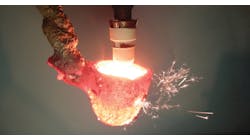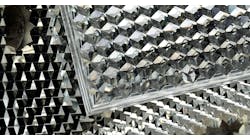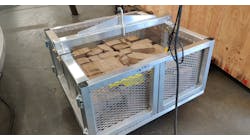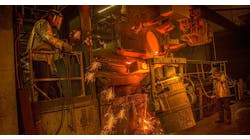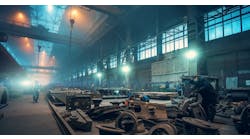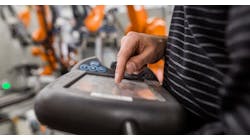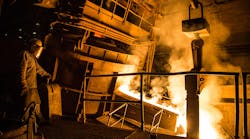The metalcasting sector is highly diversified – small to midsized enterprises up to multi-national automotive manufacturers – but there is one common denominator: they are energy-intensive operations. Iron, steel, light metals or specialty alloys; high-pressure, low-pressure, or gravity diecasting: Before metal can be poured into molds or dies, it has to be melted and held at a specific temperature for the duration of pouring – by means of coke, gas, or power.
Add to this, heat treatment of the solidified castings, which allows the desired component properties to be set in a targeted manner.
For years now the high energy prices have caused problems for German foundries, and these uncertainties have accelerated thanks to the energy market crisis resulting from the war in Ukraine. Prices for power, coal, and natural gas have risen markedly, and the scarcity of natural gas has become an existential threat. Against this backdrop, the obligation to reach climate-neutrality not only means extra costs but a considerable burden in view of average profit margins of around 4%.
Decarbonization technologies will be among the many innovations on display and in discussion at GIFA 2023, the international foundry trade fair to be held in Düsseldorf, Germany, June 12-16, 2023.
There is no such unambiguous transformation path for foundries, as there is for steelmakers – direct reduction powered by green hydrogen plus green electricity. “Each foundry has to develop its own concept for climate neutrality,” according to Elke Radtke, Environmental Protection and OSH Officer at the German Foundry Association (BDG.) “What counts for foundries is a reliable political framework – because the changeover to another melting technology is a decision taken for decades.”
Exploring all avenues
“Foundries are more than prepared to tackle the transformation to climate- neutrality,” states Dr. Ingo Steller, managing director of the Foundry Technology Research Assn. and an expert for iron and steel casting, manufacturing technology at BDG. However, Steller noted that many decarbonization projects involving bio-coke and hydrogen are still in the research phase, requiring multi-annual operational trials. BDG is currently researching technologies for CO2-avoidance (the InnoGuss project), with initial, viable results expected by mid-2023.
Metalcasting CO2 emissions come from various processes, and decarbonization is not expected only from iron casters and their coke-fired cupolas; nonferrous metalcasters’ natural-gas fired furnaces, and most holding furnaces and preheaters, are subject to the same expectations. Sources of “green” energy alternatives include bio-coke, biogas and hydrogen, but here supply alone poses a major problem: All energy-intensive industries are exploring all avenues to replace natural gas and coal.
Iron foundries
Half of all the gray iron produced in Germany is produced from coke-fired cupolas, and around 40% with electric induction furnaces. This is why electric melting is the only solution to reduce CO2-emissions to net zero by 2050, in the opinion of many casting experts. The leading induction furnace developers will be exhibiting the latest crucible furnaces at GIFA 2023, including medium-frequency crucible induction furnaces suitable for melting iron and steel.
So substituting coke-fired cupola furnaces by electric smelting is possible and addresses all the requirements of CO2-neutrality – but this is precisely the problem. In Germany, power from renewable sources will not be available in sufficient quantities for a long time, as major consumers have already secured nearly all available green power contingents. It is therefore difficult for iron foundries to become climate-neutral by means of electric melting. Rising power prices and insecure conditions are associated with additional investment risks. The target of climate neutrality by 2050 is set but the path towards it is still open.
Another drawback of crucible furnaces is that coke-fired cupolas are cheaper to install and operate. With their sophisticated metallurgy and optimized furnace campaigns, iron foundries can even turn the lowest-quality scrap into a melt for high-quality cast iron, for world-class castings – such as thin-wall and high-strength cast iron engine blocks that are as lightweight as comparable aluminum products.
Crucible furnaces require the best scrap the market has to offer. And, these materials increasingly are secured by major steel mills as they switch from blast furnace steelmaking to electric melting. Salzgitter AG, for example, has agreed with Volkswagen on a closed-loop cycle for steel between the Salzgitter Works and the automotive complex at Wolfsburg. The world’s largest steelmaker, ArcelorMittal, buys up scrap recycling companies – huge amounts of metal that are no longer available to the open market, putting smaller buyers like foundries in a fix.
Changing from cupola to a medium-sized crucible furnace is only part of a multi-million euro equation. Additional expenses include the transformer and power line, construction costs, and the losses associated with production standstill during the changeover.
Biocoke as an alternative
Biomass could provide a bridge energy source for cupola furnaces, though the operational trials are not conclusive. Made of renewable raw materials, biocoke can already contribute to decarbonization when mixed with coke. However, cupolas are still a long way from using 100% biocoke.
Challenges for foundries are many and varied here. There is no regional supply of biomass; imports represent most of the current supply. However, the carbonization of biomass is also far from foundry practice in technical terms. “Biocoke is a hope but not put into practice yet,” Steller explained, noting that little more than 10% of biocoke can be added to the charging materials for cupolas.
“For the production of foundry biocoke, waste tree trunks have to be carbonized and compacted with a binder into mechanically stable, high-temperature and pressure-resistant briquets of a sufficient size – and all of this on an industrial scale and at competitive prices,” he detailed. The small pieces of biocoke used in steelmaking are not suitable for use in foundries.
Hopes are on hydrogen
Hydrogen might be another option in the future. Pascal Kwaschny and Hans-Jörg Meissner, both with hydrogen producer Linde, in an article published in 2021, stated the use of hydrogen by foundries for combustion can as a rule contribute to a significant reduction of CO2 emissions. In particular, they wrote, this applies to downstream equipment such as a natural gas substitute for preheating ladles for nonferrous metals. Likewise, innovative concepts where waste heat is used to produce the required hydrogen might play a part in future for cupola furnaces.
Research into hydrogen use in foundries is still in an early stage, and it’s not an option for cupola furnaces now, according to estimates by foundry experts like Steller. “More investment and research are needed for this,” he said. There are some tests showing that hydrogen burners could work, but according to Steller these cannot be transferred in a 1:1 scale. “There are no practical tests with cupola furnaces yet; it is not yet known how these burners with their higher temperatures would work with the charge make-up as found in a cupola.”
Green power for other foundries
Steel foundries melt high-quality steel scrap exclusively, using thermal energy from power in electric arc furnaces – smaller but similar to EAFs used in steelmaking – and increasingly also in induction furnaces. Here, power from renewable sources is the energy of choice. The liquid steel produced is characterized by its high purity and this can be processed further in secondary metallurgy lines. Often the cast product undergoes heat treatment, and if that downstream treatment is done with natural gas, a mixture of and/or replacement by biogas could be one option for decarbonization.
For nonferrous metalcasting, approximately 70% of the 3,000 to 4,000 melting units in German foundries are fired with fossil fuels, especially natural gas. Biogas could be mixed with – or potentially, replace it – the gas, to contribute to decarbonization. However, more research and practical trials have to be conducted. Hydrogen as a natural gas replacement probably qualifies best for pre-heating furnaces; the research needed here is comparable to that for hydrogen use in cupolas. Induction heating has not undergone a great deal of testing here and faces similar challenges as the use of crucible induction melting furnaces.
Identifying transformation pathways for CO2 reduction is the aim of BDG’s InnoGuss research initiative. With a roadmap for climate neutrality, experts from the association, research centers, and the industry are already studying technologies from other energy-intensive sectors. “The aim is to find out which technology can be adapted for foundries,” according to Steller. InnoGuss is scheduled to run until mid-2023, and probably longer. Then it will be up to plant manufacturers to deliver.

